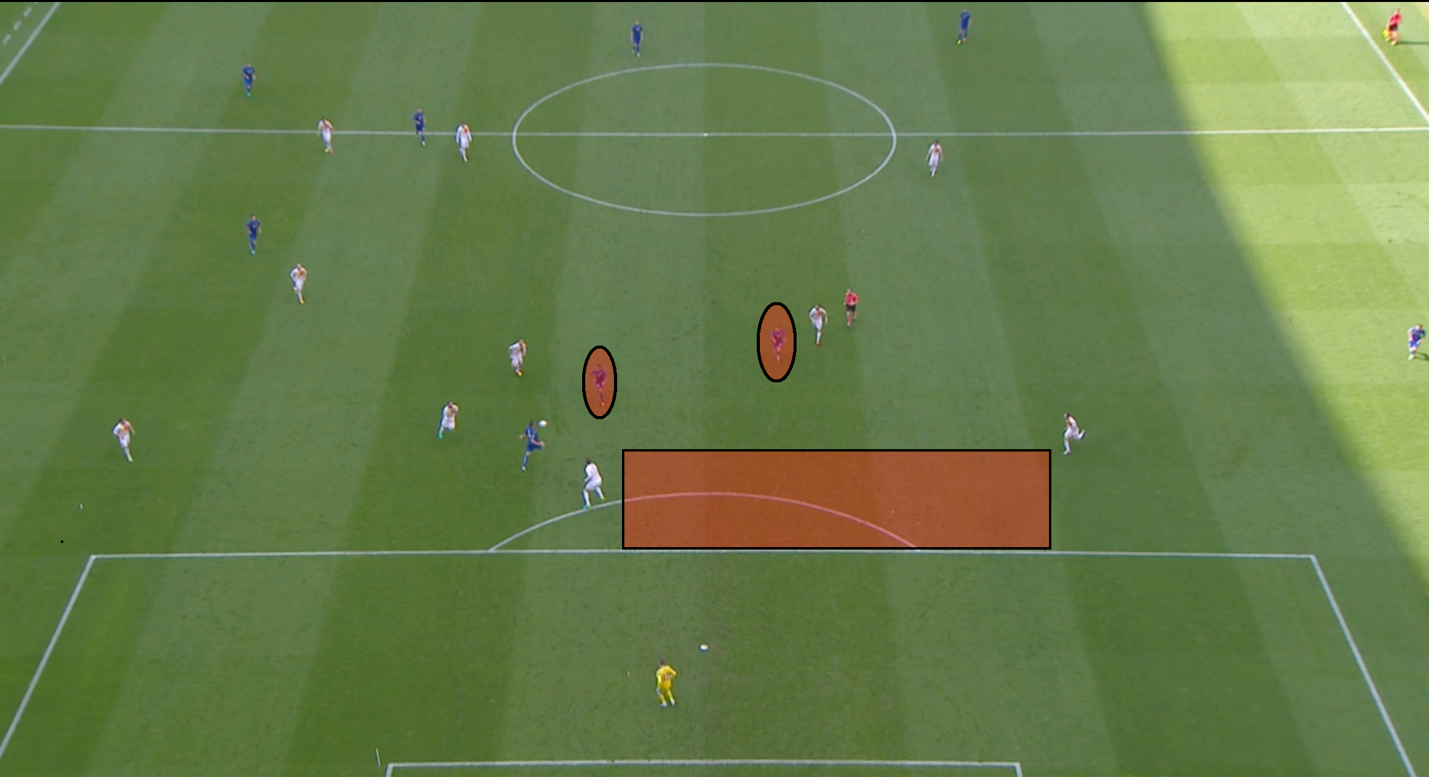Hamoudi Fayad writes a detailed tactical analysis of the very entertaining Euro 2016 second round match that ended Italy 2-0 Spain.
Italy once again beat a title contender via the same fashion, this time to move into the quarter finals of the Euro 2016 where they will face world champions Germany. Their tactical intelligence was on show yet again, while the Spaniards showed shades of 2014 as a lack of solutions against Italy’s block got the better of them.
Italy: 1. Buffon; 15. Barzagli; 19. Bonnucci; 3. Chiellini; 22. De Rossi; 18. Parolo; 8. Florenzi; 2. Sciglio ; 17. Eder; 9. Pelle; 23. Giacherrini.
Spain: 13. De Gea; 16. Juanfran; 3. Pique; 15. Sergio Ramos; 18. Jordi Alba; 5. Busquets; 6. Iniesta; 10. Cesc; 21. Silva; 7. Morata; 22. Nolito.

Italy played with their usual 5-3-2 formation that relied on the dynamic movement of Giaccherini to support the strikers, which worked to near perfection against a team that were considered favourites for the title. Their back 5 also got involved with the attack to a level greater than normal defenders do.
The front 3 of Spain tried to face Italy’s defenders man-to-man while they used their full backs and Iniesta to look for solutions to thwart the Italian defence to no avail. Italy’s compactness and pressing traps, also with Fabregas’ inability to exploit the space behind Giaccherini’s forward runs led to an overall drab day in the Spanish midfield service.
Spain without any solutions against Italy block
Spain tried a variety of ways to get the ball past Italy’s trio in midfield first, and then their trio in defence. Unfortunately for them, the first of their problems was that Busquets was off his game and was being marked by Graziano Pelle up front. Busquets lacked support in this match and often pushed up to counter press which allowed space behind him, ultimately leading to the first goal of the match.
With Busquets out of the picture, Spain used their 3 attackers to face Italy’s defenders 1v1. This was used to halt Italy’s progression up the pitch but not with the full intention of winning the ball back which was an odd decision to say the least. The reason for this came in the form of Italy’s defenders’ ability to play the ball out of the back under almost any circumstance. Their defenders used their knack of utilizing the ball against pressure effectively to bypass a very simple pressing structure from La Roja.
To battle this, Italy’s defenders either shifted out wide with the ball to draw one of Spain’s interiores out of their shape, or De Rossi would drop deeper to form a 4v3 overload against Spain’s attackers to allow the progression of play to occur.
Spain on the day heavily relied on crossing but initially they used a crossing type very popular at this tournament which is the aerial diagonal cutback. Morata scored against Turkey in this way and so did Ronaldo against Hungary. This is also used by Messi to reach Neymar or Alba at the other half space, but Silva’s utilization of this type of cross didn’t produce the required results. Later on they used the most common (and least successful) form of crossing. Against a defence like Italy’s, chances are that will be as a result of a lack of ideas – in this case it was, especially for a team in the mould of Spain.
They proceeded to draw Giaccherini out of his position in the 5-3-2 (a pressing trap from Italy, where the ball-near outer central midfielder would push up to press), play it to a full back out wide and play the ball to one of the interiores in the half space. However, even as shown in the image below where Fabregas comfortably received the ball, the Italian defenders’ 1v1 capabilities delayed the progression of the Spanish attack and they were back in the same position, surrounded with little option but to maneuver just a few yards ahead.

Truly a pressing ‘trap’, Italy’s unit make you feel free to receive the ball in those acres of space in between the hexagon of Italian players and the space behind De Sciglio.
Italian defenders pivotal to success
Someone asked me how on earth Italy manage to keep their shape without being exploited with relative ease. This was true, where even the centre backs had the freedom to push up with and without the ball to threaten their opponents from deep. Bonucci, akin to a deep lying playmaker but really a centre back, was once again a playmaking outlet for Italy. Barzagli, another centre back similarly built play from deep.
#ITA mode of attack: vertical passes to players in btwn the lines pic.twitter.com/VluWGbXg6V
— Hamoudi | محمد (@Hamoudi_LFC8) June 27, 2016
Parolo doesn’t offer much in terms of build-up while Giaccherini is focused on affecting the final third with his nimble running and De Rossi himself is a platform for Italy’s defenders to rely on for aid and support. Therefore, Italy need creativity from somewhere. In this case it is their centre backs who use their feet to stimulate the play. Grounded passes to the forwards are used. They receive it on the half turn and proceed to face the defenders on the counter attack. Otherwise, Bonucci, an expert, plays accurate aerial passes to Pelle who brings the ball down to Eder – the latter playing off him for the most part.

Eder and Giaccherini, both circled in red, were the penetrative options for Italy.
One more form of attacking that the defenders played a big role in was the progression of the ball through the flanks and back inside to the centre. It wasn’t always simple square passes back into the centre but diagonal switches of play to surprise Spain and subsequently have Pelle use his body to hold the ball up and link with the onrushing attackers. Surprisingly, the Italians were much better than Spain in this sense.
Spain, always known for their ability to execute the Salida La Volpiana (where the defensive midfielder drops in between the centre backs as the full backs push up), didn’t do so over the course of the match. The general rule is that against two strikers, the defensive midfielder should drop to keep an overload. Yet against Pelle and Eder, this wasn’t the case.
Italy pressing traps
Italy’s pressing traps were similar to the ones against Belgium. This allowed their defenders to push up outside of the shape and not suffer as a repercussion. The position-oriented pressing was visible with the wing backs, who pushed up to form a 4-4-2 – adding to the 3-man midfield shape as wide midfielders. Otherwise, as previously shown, the ball-near outer midfielder (Parolo or Giaccherini) would move forward to stop Spain from building play easily. This worked to tempt the Spanish midfielders into playing into areas where they would lose the ball or find no way to progress through the pitch.
Second half developments
In the second half, Spain took complete control of possession (at a point they had 75% for a quarter of an hour) against Italy’s deep block who still were able to find spaces against Spain on the counter attack. The introduction of Lorenzo Insigne further highlighted this point and Italy went on to score the second of the match. One thing Italy managed to do was open Spain up quite easily. When they had the chance to build up, Spain’s central zones would be wide open as shown in the image below. Once Italy exploited this on the counter attack, a centre back would be drawn out and in the following scenario, Pique hacked an Italy player down to halt what could have been a goalscoring chance.

Spain’s central zones similar to Hungary the day before: wide open.
Conclusion
In conclusion, Italy’s performance supported the theory that they perform better against stronger opponents, or opponents who take control of the ball for the most part, than against teams that play without it such as Iceland and Sweden. Spain, meanwhile, will look for a new manager, as a dominant reign has now officially been brought to a crashing halt.
Written by Hamoudi Fayad.
- Hipster Guide 2016-17: Bayer Leverkusen’s tactics, key players and emerging talents - August 25, 2016
- Talent Radar: Saudi Pro League 10 Young Players (U-23) to Watch in 2016-17 - August 23, 2016
- Dry Grassroots: Youth Football Deficiencies in Western Asia - July 19, 2016






















































